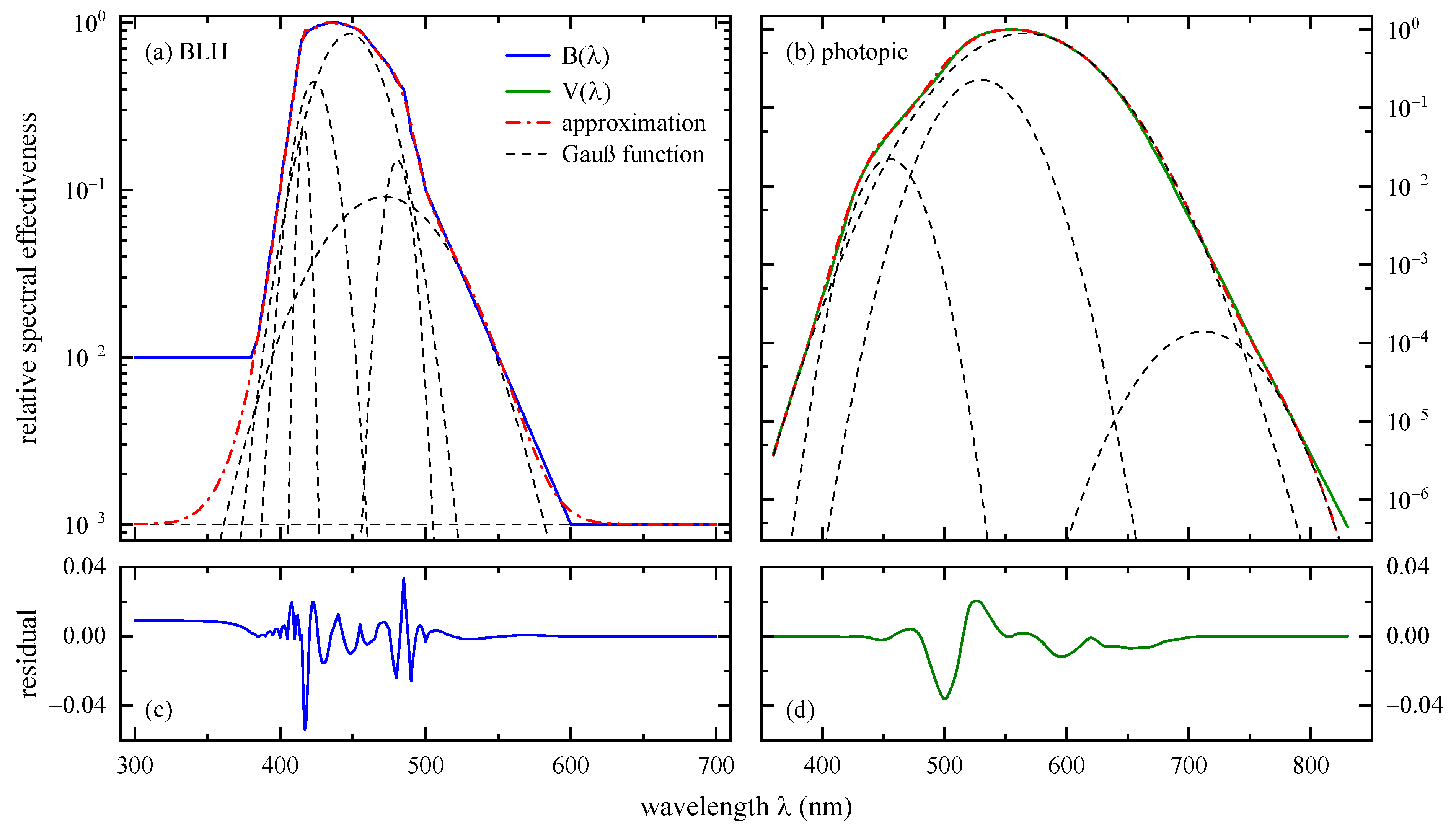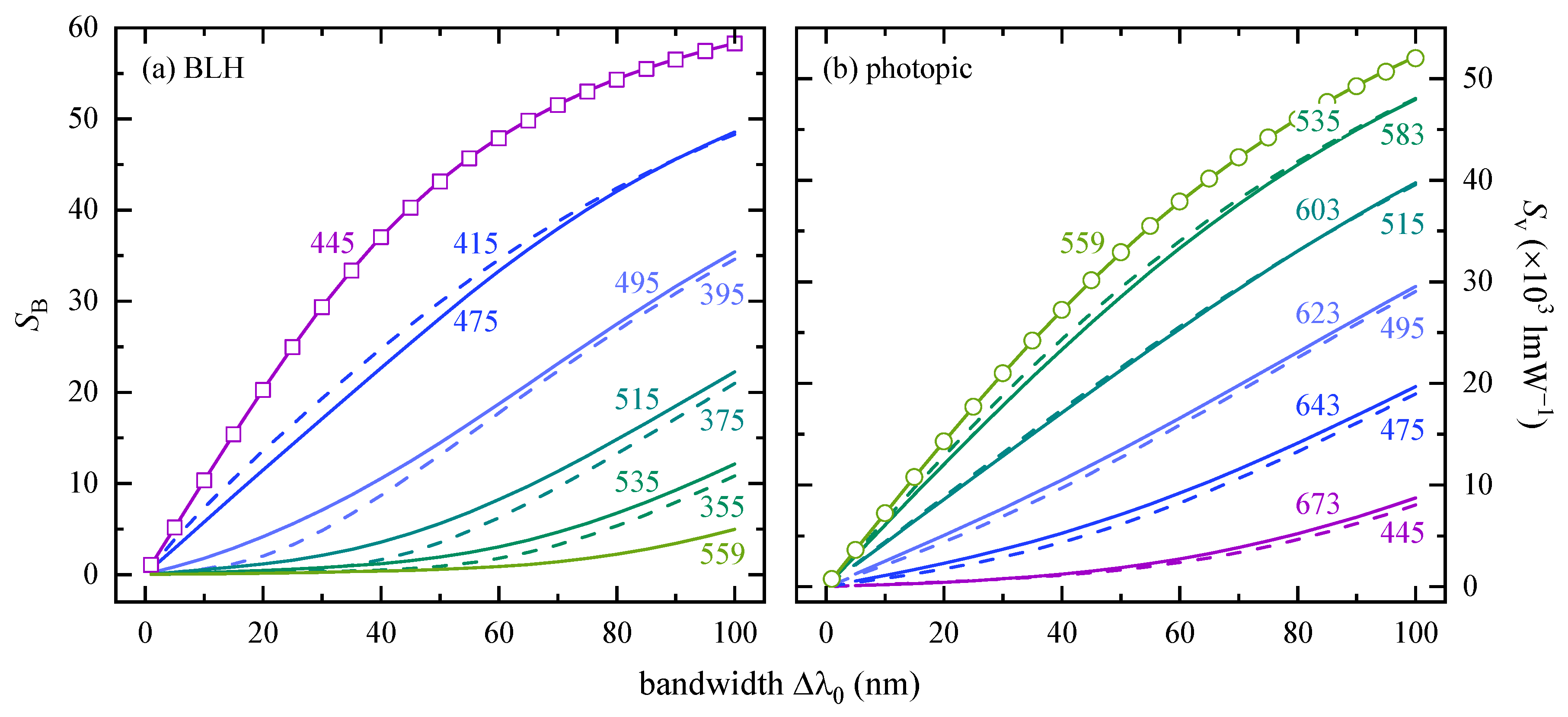Blue-Light Hazard of Light-Emitting Diodes Assessed with Gaussian Functions
Abstract
:1. Introduction
2. Materials and Methods
2.1. LED Emission Spectra
2.2. Relative Spectral Effectiveness
2.2.1. Blue-Light Hazard Action Spectrum
2.2.2. Spectral Luminous Efficiency for Photopic Vision
2.3. Signal Weighting and Related Quantities
3. Results and Discussion
3.1. Color LEDs
3.1.1. Analytical Solutions
3.1.2. Weighted LED Signals
3.1.3. Processed BLH Quantities
3.2. Phosphor Conversion White LEDs
3.2.1. Parameter Variation Limits
3.2.2. Chromaticity Coordinates
3.2.3. CCT Dependent BLH
3.3. Experimental Accuracy Test
4. Conclusions
Funding
Institutional Review Board Statement
Informed Consent Statement
Data Availability Statement
Conflicts of Interest
Appendix A
Appendix A.1. Chromaticity Coordinates
Appendix A.2. Correlated Color Temperature
References
- Tsao, J.Y.; Han, J.; Haitz, R.H.; Pattison, P.M. The blue LED Nobel prize: Historical context, current scientific understanding, human benefit. Ann. Phys. 2015, 527, A53–A61. [Google Scholar] [CrossRef] [Green Version]
- Wyszecki, G.; Stiles, W.S. Color Science: Concepts and Methods, Quantitative Data and Formulae, 2nd ed.; Wiley: New York, NY, USA, 2000. [Google Scholar]
- Bando, K.; Sakano, K.; Noguchi, Y.; Shimizu, Y. Development of high-bright and pure-white LED lamps. J. Light Vis. Environ. 1998, 22, 2–5. [Google Scholar] [CrossRef]
- Narukawa, Y.; Ichikawa, M.; Sanga, D.; Sano, M.; Mukai, T. White light emitting diodes with super-high luminous efficacy. J. Phys. D Appl. Phys. 2010, 43, 354002. [Google Scholar] [CrossRef]
- Hunter, J.J.; Morgan, J.I.W.; Merigan, W.H.; Sliney, D.H.; Sparrow, J.R.; Williams, D.R. The susceptibility of the retina to photochemical damage from visible light. Prog. Retin. Eye Res. 2012, 31, 28–42. [Google Scholar] [CrossRef] [PubMed] [Green Version]
- International Commission on Non-Ionizing Radiation Protection. ICNIRP guidelines on limits of exposure to incoherent visible and infrared radiation. Health Phys. 2013, 105, 74–96. [Google Scholar] [CrossRef]
- Mahmoud, B.H.; Hexsel, C.L.; Hamzavi, I.H.; Lim, H.W. Effects of Visible Light on Skin. Photochem. Photobiol. 2008, 84, 450–462. [Google Scholar] [CrossRef] [PubMed]
- Touitou, Y.; Point, S. Effects and mechanism of action of light-emitting diodes on the human retina and internal clock. Environ. Res. 2020, 190, 109942. [Google Scholar] [CrossRef] [PubMed]
- Sliney, D.H. Almost all lamps are safe but safety of new Lamps is questioned. Light Eng. 2014, 22, 12–23. [Google Scholar]
- Modenese, A.; Gobba, F. Macular degeneration and occupational risk factors: A systematic review. Int. Arch. Occ. Environ. Health 2019, 92, 1–11. [Google Scholar] [CrossRef] [Green Version]
- Schierz, C. Is light with lack of red spectral components a risk factor for age-related macular degeneration (AMD)? In Proceedings of the 29th CIE Session, Washington, DC, USA, 14–22 June 2019. [Google Scholar] [CrossRef]
- Bullough, J.D.; Bierman, A.; Rea, M.S. Evaluating the blue-light hazard from solid state lighting. JOSE 2017, 25, 311–320. [Google Scholar] [CrossRef]
- International Commission on Illumination. CIE position statement on the blue light hazard. Color Res. Appl. 2019, 44, 672–673. [Google Scholar] [CrossRef]
- O’Hagan, J.B.; Khazova, M.; Price, L.L.A. Low-energy light bulbs, computers, tablets and the blue light hazard. Eye 2016, 30, 230–233. [Google Scholar] [CrossRef] [PubMed] [Green Version]
- International Commission on Non-Ionizing Radiation Protection. Light-emitting diodes (LEDs): Implications for safety. Health Phys. 2020, 118, 549–561. [Google Scholar] [CrossRef] [PubMed]
- Shibuya, T.; Akiba, T.; Iwanaga, T. Assessment of the blue light hazard for light sources with non-uniform luminance. LEUKOS 2020. [Google Scholar] [CrossRef]
- International Electrotechnical Commission. IEC 62471:2006 Photobiological Safety of Lamps and Lamp Systems; IEC: Geneva, Switzerland, 2006. [Google Scholar]
- Pan, J.; Li, Q.C.; Chen, C. Key aspects of photobiological safety measurements. Light Eng. 2014, 22, 34–41. [Google Scholar]
- Moreno, I.; Sun, C.C. Modelling the radiation pattern of LEDs. Opt. Express 2008, 16, 1808–1819. [Google Scholar] [CrossRef]
- Ohno, Y. Spectral design considerations for white LED color rendering. Opt. Eng. 2005, 44, 111302. [Google Scholar] [CrossRef]
- Morkoç, H. Handbook of Nitride Semiconductors and Devices Volume 3, GaN-Based Optical and Electronic Devices, 1st ed.; Wiley-VCH: Weinheim, Germany, 2009. [Google Scholar]
- German Institute for Standardization. DIN 5031-10:2018-03 Optical Radiation Physics and Illuminating Engineering—Part 10: Photobiologically Effective Radiation, Quantities, Symbols and Action Spectra; Deutsches Institut für Normung: Berlin/Heidelberg, Germany, 2018. [Google Scholar]
- International Commission on Non-Ionizing Radiation Protection. Guidelines on limits of exposure to broad-band incoherent optical radiation (0.38 to 3 µm). Health Phys. 1997, 73, 539–554. [Google Scholar]
- Chaopu, Y.; Wenqing, F.; Jiancheng, T.; Fan, Y.; Yanfeng, L.; Chun, L. Change of blue light hazard and circadian effect of LED backlight displayer with color temperature and age. Opt. Express 2018, 26, 27021–27032. [Google Scholar] [CrossRef]
- International Organization for Standardization/International Commission on Illumination. ISO/CIE 11664-1:2019-06 Colorimetry—Part 1: CIE Standard Colorimetric Observers; CIE: Geneva, Switzerland, 2019. [Google Scholar]
- Judd, D.B. Report of U.S. Secretariat Committee on colorimetry and artificial daylight. 1951. In Proceedings of the Twelfth Session of the CIE 1951, Paris, France, 18 April 1951. [Google Scholar]
- Sharpe, L.T.; Stockman, A.; Jagla, W.; Jägle, H. A luminous efficiency function, V*(λ) for daylight adaptation. J. Vision 2005, 5, 948–968. [Google Scholar] [CrossRef] [Green Version]
- Vos, J.J. Colorimetric and photometric properties of a 2° fundamental observer. Color Res. Appl. 1978, 3, 125–128. [Google Scholar] [CrossRef]
- International Electrotechnical Commission. IEC TR 62778:2014 Application of IEC 62471 for the Assessment of Blue Light Hazard to Light Sources and Luminaires; IEC: Geneva, Switzerland, 2014. [Google Scholar]
- Chhajed, S.; Xi, Y.; Li, Y.L.; Gessmann, T.; Schubert, E.F. Influence of junction temperature on chromaticity and color-rendering properties of trichromatic white-light sources based on light-emitting diodes. J. Appl. Phys. 2005, 97, 054506. [Google Scholar] [CrossRef]
- Li, Y.L.; Gessmann, T.; Schubert, E.F.; Sheu, J.K. Carrier dynamics in nitride-based light-emitting p-n junction diodes with two active regions emitting at different wavelengths. J. Appl. Phys. 2003, 94, 2167–2172. [Google Scholar] [CrossRef] [Green Version]
- Houser, K.W. The problem with luminous efficacy. LEUKOS 2020, 16, 97. [Google Scholar] [CrossRef] [Green Version]
- Chen, S.; Wei, M. Chromaticities for producing white stimuli depend on viewing mode rather than viewing medium: A pilot study. LEUKOS 2020, 16, 255–265. [Google Scholar] [CrossRef]
- International Organization for Standardization. ISO 11476:2016-08 Paper and Board—Determination of CIE Whiteness, C/2° (indoor illumination conditions); ISO: Geneva, Switzerland, 2016. [Google Scholar]
- International Organization for Standardization. ISO 11475:2017 Paper and Board—Determination of CIE Whiteness, D65/10° (outdoor daylight); ISO: Geneva, Switzerland, 2017. [Google Scholar]
- Yamada, K.; Imai, Y.; Ishii, K. Optical simulation of light source devices composed of blue LEDs and YAG phosphor. J. Light Vis. Environ. 2003, 27, 70–74. [Google Scholar] [CrossRef] [Green Version]
- Houser, K.W.; Wei, M.; David, A.; Krames, M.R. Whiteness perception under LED illumination. LEUKOS 2014, 10, 165–180. [Google Scholar] [CrossRef]
- Hunt, R.W.G.; Pointer, M.R. Measuring Colour, 4th ed.; Wiley: West Sussex, UK, 2011. [Google Scholar]
- International Organization for Standardization/International Commission on Illumination. ISO/CIE 11664-3:2019-06 Colorimetry—Part 3: CIE Tristimulus Values; ISO: Geneva, Switzerland, 2019. [Google Scholar]
- McCamy, C.S. Correlated color temperature as an explicit function of chromaticity coordinates. Color. Res. Appl. 1992, 17, 142–144. [Google Scholar] [CrossRef]
- Hernández-Andrés, J.; Lee, R.L.; Romero, J. Calculating correlated color temperature across the entire gamut of daylight and skylight chromaticities. Appl. Opt. 1999, 38, 5703–5709. [Google Scholar] [CrossRef]
- Li, C.; Cui, G.; Melgosa, M.; Ruan, X.; Zhang, Y.; Ma, L.; Xiao, K.; Luo, M.R. Accurate method for computing correlated color temperature. Opt. Express 2016, 24, 14066–14078. [Google Scholar] [CrossRef] [Green Version]







| 1 | 0.2361 | 416.136 | 20.276 |
| 2 | 0.4443 | 423.378 | 215.925 |
| 3 | 0.8606 | 447.663 | 804.406 |
| 4 | 0.1505 | 480.662 | 118.811 |
| 5 | 0.0908 | 471.588 | 2697.525 |
| 6 | 0.895 ± 0.007 | 566 ± 1 | 3422 ± 22 |
| 7 | 0.23 ± 0.02 | 530.5 ± 0.2 | 1190 ± 30 |
| 8 | 0.023 ± 0.003 | 455 ± 1 | 576 ± 30 |
| 9 | 0.00014 ± 0.0011 | 712 ± 36 | 2000 ± 6000 |
| Name (Manufacturer) | Label | |||||
|---|---|---|---|---|---|---|
| 1 | Diamond Dragon, W5AP (OSRAM) | LUW | 451|25|1 | 551|131|0.41 | 9061 | |
| 2 | LCW | 456|33|0.66 | 589|154|1 | 3403 | ||
| 3 | LB | 464 | 462|27|1 | |||
| 4 | LB #2 | 464 | 462|26|1 | |||
| 5 | LT #2 | 527 | 523|38|1 | |||
| 6 | LT | 531 | 529|44|1 | |||
| 7 | LR | 636 | 639|17|1 | |||
| 8 | ELS (Roithner) | blue | 466 | 464|22|1 | ||
| 9 | green | 519 | 515|33|1 | |||
| 10 | amber | 595 | 596|14|1 | |||
| 11 | red | 626 | 629|16|1 | |||
| 12 | Golden Dragon (OSRAM) | LUW W5KM | 438|23|1 | 550|127|0.35 | 8487 | |
| 13 | LUW W5SM | 442|27|1 | 551|128|0.40 | 9573 | ||
| 14 | LUW W5SM #2 | 446|30|1 | 550|130|0.32 | 24,140 | ||
| 15 | LW W51M | 453|24|1 | 562|132|0.55 | 5770 | ||
| 16 | ZW W5SG | 454|25|1 | 563|130|0.48 | 6246 | ||
| 17 | LCW W5SM #2 | 455|27|0.79 | 591|129|1 | 3168 | ||
| 18 | LCW W5SM | 456|28|0.78 | 590|129|1 | 3198 | ||
| 19 | LW W55M | 456|26|1 | 562|135|0.38 | 8458 | ||
| 20 | LCW W55M | 459|29|1 | 597|161|0.98 | 3514 | ||
| 21 | LCW W51M | 461|26|0.46 | 597|160|1 | 3097 | ||
| 22 | LB W5SM | 465 | 464|29|1 | |||
| 23 | Golden Dragon Plus, W5AM (OSRAM) | LUW | 441|25|1 | 551|127|0.44 | 7854 | |
| 24 | LW | 452|28|1 | 560|130|0.44 | 7953 | ||
| 25 | LY | 596 | 598|15|1 | |||
| 26 | LA | 622 | 626|17|1 | |||
| 27 | LR | 636 | 639|19|1 | |||
| 28 | HP 803 (Roithner) | NW | 460|28|1 | 553|135|0.30 | 16,914 | |
| 29 | NB | 469 | 469|34|1 | |||
| 30 | NR | 630 | 636|15|1 | |||
| 31 | MR-16 (Omnilux) | cool white | 450|27|1 | 556|127|0.46 | 7698 | |
| 32 | warm white | 460|28|0.55 | 582|105|1 | 3460 | ||
| 33 | blue | 461 | 461|29|1 | |||
| 34 | green | 523 | 520|36|1 | |||
| 35 | yellow | 597 | 600|16|1 | |||
| 36 | red | 636 | 641|18|1 | |||
| 37 | Paulmann | LED-Reflector | 450|24|1 | 557|124|0.55 | 6051 | |
| 38 | Platinum Dragon, W5SN (OSRAM) | LW | 452|31|1 | 564|133|0.62 | 5943 | |
| 39 | LCW | 458|26|0.93 | 589|129|1 | 3314 | ||
| 40 | LA | 625 | 628|17|1 | |||
| 41 | LR #2 | 631 | 635|17|1 | |||
| 42 | LR | 633 | 637|18|1 |
Publisher’s Note: MDPI stays neutral with regard to jurisdictional claims in published maps and institutional affiliations. |
© 2021 by the author. Licensee MDPI, Basel, Switzerland. This article is an open access article distributed under the terms and conditions of the Creative Commons Attribution (CC BY) license (http://creativecommons.org/licenses/by/4.0/).
Share and Cite
Bauer, S. Blue-Light Hazard of Light-Emitting Diodes Assessed with Gaussian Functions. Int. J. Environ. Res. Public Health 2021, 18, 680. https://doi.org/10.3390/ijerph18020680
Bauer S. Blue-Light Hazard of Light-Emitting Diodes Assessed with Gaussian Functions. International Journal of Environmental Research and Public Health. 2021; 18(2):680. https://doi.org/10.3390/ijerph18020680
Chicago/Turabian StyleBauer, Stefan. 2021. "Blue-Light Hazard of Light-Emitting Diodes Assessed with Gaussian Functions" International Journal of Environmental Research and Public Health 18, no. 2: 680. https://doi.org/10.3390/ijerph18020680





